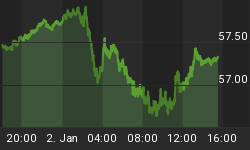An idealist is one who, on noticing that a rose smells better than a cabbage, concludes that it is also more nourishing.
- L. Mencken
Many pundits associate higher copper prices with inflation. While this is true to a degree, that is the wrong metric to focus on. Higher copper prices are usually associated with an improving economy. For the past few years, Copper which is a leading indicator did not trend in sync with the markets. It was marching to a different drum beat, but a new trend could be in the works.

Copper has traded past a key resistance point ($3.00), and it has managed to close above this important level on a monthly basis. The long term outlook for copper is now bullish and will remain so as long as it does not close below $2.80 on a monthly basis. Copper is facing resistance in the 3.20-3.25 ranges and as it is now trading in the extremely overbought ranges. As copper is now trading in the extremely overbought ranges, it is more likely to let out some steam before trading past this zone. A healthy consolidation should provide copper with the force needed to challenge the $3.20 ranges and trade as high as $3.80 with a possible overshoot to $4.00, provided it does not close below $2.80 on a monthly basis.
Now that copper has traded past $3.00 on a monthly basis, the Fed deserves another pat on the back for they have managed to further cement the illusion that this economic recovery is real. Copper is seen as a barometer for economic growth, so pulling off a Houdini is probably going to propel a lot of former naysayers to embrace this economic recovery.
What about the Inflation issue?
Should we start to worry about inflation, now that copper prices are trending higher? We would prefer to look at it from a different angle; higher copper prices in the past were associated with an improving economy. For a long time, this indicator like the Baltic dry index diverged, but now it appears copper is dancing to the same tune as the Stock Market
Don’t focus on the inflationary factor, as we are not operating in normal times. The Fed opened Pandora's box so expect the unexpected.
Greenspan raised rates from 1% in 2004 to 5.25% in 2006 and long term rates hardly budged. The Fed today is in no position to act as aggressively and on a worldwide basis, central bankers are preparing for deflation as opposed to inflation.

Long term rates are trending upwards, but the Fed has already changed its tune and appears to be taking a more dovish stance.
"Because the neutral rate is currently quite low by historical standards, the federal fund's rate would not have to rise all that much further to get to a neutral policy stance," Yellen will tell Congress.
In a twist, the bond market did not trade to new lows after the last rate hike. In fact, it put in a higher low and has been trending upwards. The bond market has completely shrugged off the effects of the last rate hike.

Bonds bottomed out in March, and since then they have been trending upwards. A monthly close above 158 should lead to a test of the 164 ranges.
Last but not least, the velocity of M2 money stock continues to trend downwards. Inflation will remain a non-issue until it starts to trend upwards. We also have a plethora of deflationary factors to consider, grocery wars that will escalate now with Amazon’s purchase of Whole Foods, automation and AI, etc.
Irony is the form of paradox. Paradox is what is good and great at the same time.
Friedrich Schlegel
By Sol Pahla


















